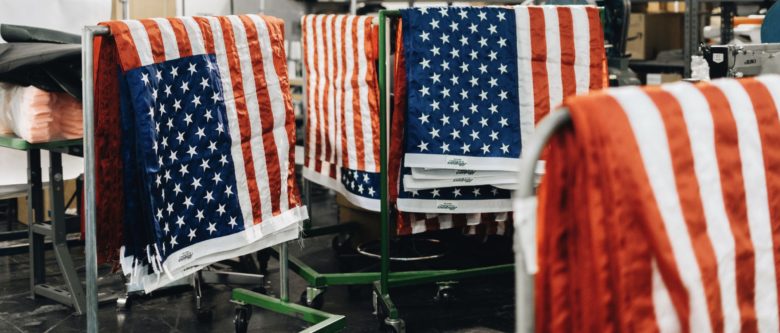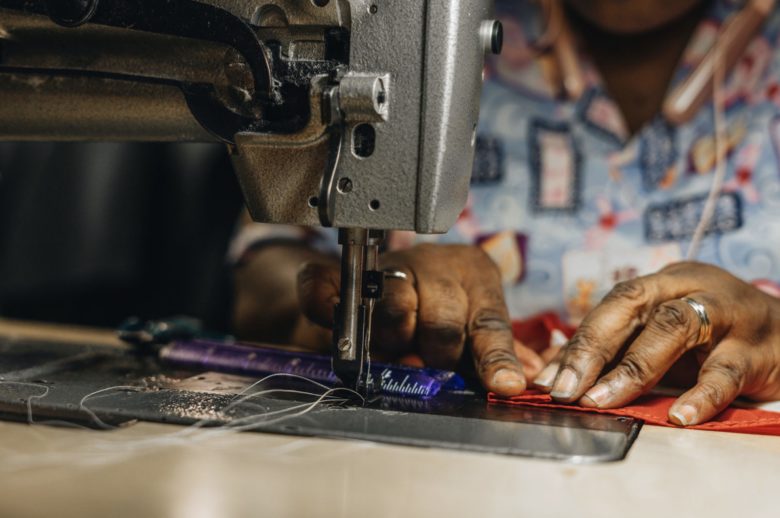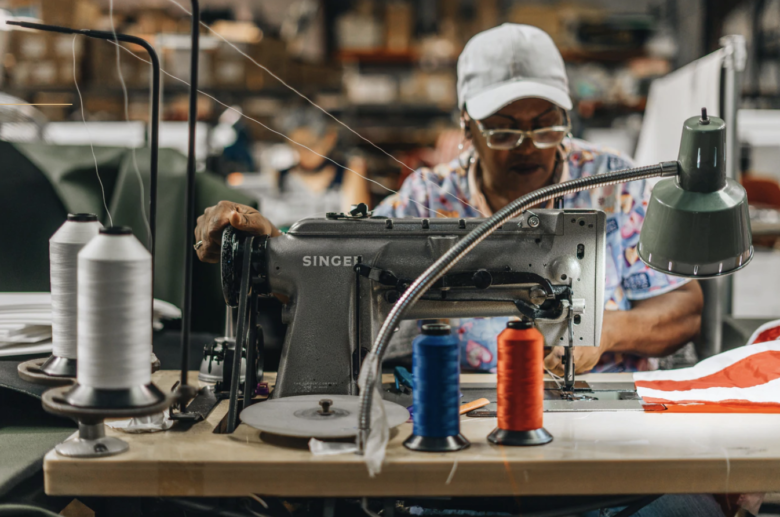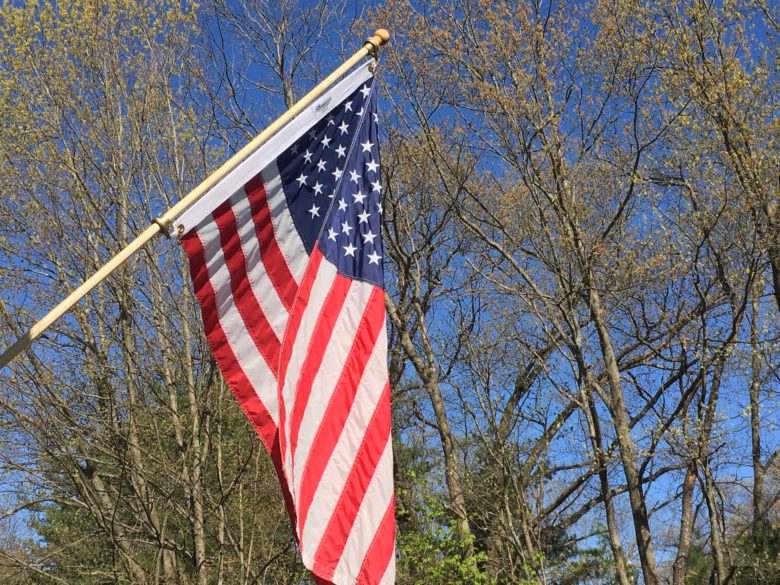
I put myself through college making sails for sailboats – meaning, I was an industrial seamstress.
Sewing is tough on the fingers, hands, and arms. Because you’re handling material all day, your hands get dirty and your nails break. Your cuticles dry out and get ragged, no matter how much hand cream you use.
At the end of the day, you’re physically and mentally tired. Learning how to sew straight is a real skill that takes months, if not years, of practice.
Concentration is paramount: If you don’t pay attention, you can inadvertently sew through material and leave holes where there shouldn’t be holes. Or your seam goes crooked and you have to stop, rip it out, and restitch – which costs time.
It’s this expertise I saw when I first viewed this photo of a seamstress’ hands sewing a US flag on the Allegiance Flag website. Her hands show experience, skill, and the years of hard work.

“I’m so glad you said that,” said Wes Lyon, co-founder of Allegiance Flag, during our call. “Our seamstresses have a lot of pride in what they do. Many of them lost their jobs when textile manufacturing left the United States. They play a huge role in what makes our flags different.”
Tattered flag leads to a question: “Can we do it better?”
If you’ve flown a flag, you’re likely aware of the problems: The flag wraps around the pole; due to weather, and pole wrapping, the nylon fades and begins to shred – meaning you have to replace the flag every few years.
When purchasing a new flag, you have to carefully check the country of manufacture: Not all US flags are made in the United States.
“It was our own tattered flag at our house that got my co-founders and me asking questions and doing research,” says Wes. “What we learned is that mass-produced flags are made using second-run nylon. The stripes may not be cut and sewn; even the stars might be printed. If you buy a flag kit, the flag might be made in the US, but not the hardware.
“We also learned that you couldn’t buy a flag via a direct-to-consumer purchasing model. Everything was sold through distributor networks, which included big box stores and even supermarkets.”
Seeing opportunity, Wes, his wife Katie Lyon, and their friend Max Berry launched Allegiance Flag in 2018.
“Our flag was too nice”
To solve the challenges the co-founders saw with existing flags, they made the decision to go above and beyond. Flag stripes were cut and sewn. Stars were hand-appliquéd.
They ended up creating the Rolls-Royce of flags, when what they really needed was a Lexus.
Says Wes, “Because our process was so labor intensive, we had to charge $200 or more for a flag. Max and I had e-comm experience and assumed that sales would flow once we flipped the switch on our website. Nope. My mother-in-law bought the first 20 flags and gave them to friends to help us out. It was a rude awakening.”
The team had to learn marketing, textile manufacturing, warehousing and fulfillment, inventory, and the myriad other details that come with creating a product – while working full-time corporate jobs.
They made changes, including removing steps from the sewing process. They also hired an industry expert who taught them the ins and outs of flag manufacturing.
Bringing production in-house
When they first started, the Allegiance team contracted with cut and sew shops in various states to make the flags.
Once sales began picking up in 2020 – allowing the three founders to quit their corporate jobs – they brought production in-house.
Each flag is made from US-sourced, first-run 200 denier nylon, which is durable enough to withstand harsh weather but light enough to catch a breeze. Flag stripes are cut and then double-needle stitched to lock seams in place. Stress points incorporate bar tacks.
“We currently have nine seamstresses,” says Wes. “We make the majority of our flags in house but still work with one cut and sew shop out of state, which is owned by the industry expert that helped us set up our own shop. Creating jobs and keeping people employed, including our third-generation seamstresses, is a commitment we’ve made.”

The company also supports five military non-profit partners at the national level, as well as having pledged to provide concourse flags for the Charleston RiverDogs’ Military Appreciation Nights for the 2022 season.
Flag kit – all accessories made in the USA!
Wes and I initially met when he reached out to see if I did PR; I said no, but since I had reviewed his website, I told him about my own industrial sewing experience and we ended up talking about how Allegiance makes their flags.
I also had a tattered flag sitting in my garage and had put off ordering another one. After talking to Wes, I ordered their 3’x5’ flag kit.
Once the flag arrived, I could see the difference as soon as I pulled it out of the container – the entire flag, from the nylon to the construction, says high-quality craftsmanship.
The kit came with a wooden pole made of Vermont Ash, a black cast iron bracket, and brass spinners – and everything is made in the US.
The brass spinners ensure the flag doesn’t wrap around the pole. With my old flag, I’d have to climb on a step ladder to unravel it several times a week. Drove me crazy. It ended up shredding due to constantly getting caught on the bracket thumb screw.

As soon as I had the new flag flying, my neighbor came over. “Wow!” she said, “That’s a gorgeous flag! I need a flag for my house.”
“Allegiance Flag in South Carolina,” I replied. “Go online to ‘showallegiance.com’ and order one. It’s super easy, and the entire kit is made here in the US.”
My neighbor nailed it: The flag is gorgeous and the rich colors of the nylon and the sewn stripes and stars make a real statement. Each time I pull into my driveway now, I think, “Damn, that’s a good-looking flag.”
What I love best, though, is knowing skilled seamstresses in South Carolina made it with their own hands – and the pride that went into their work. It definitely shows.
That’s what American manufacturing – and keeping jobs here – is all about. Quality, craftsmanship, and pride in a job well done.
To learn more about Allegiance Flag, and to order a new one for the upcoming US holidays, visit their website: www.showallegiance.com.
And, be sure to check out the website’s “This Week in American History” section. Each week, Allegiance sends out an email with events that happened for the current week. (Haha — the theme song to Welcome Back Kotter was the #1 pop single the week of May 8, 1975. Loved that show.) According to Wes, they’ve received feedback that customers use these emails as discussion points with children around the dinner table.
What to do with an old flag
You can send old or torn flags to your local Boy Scout troop or VFW. Either group will properly retire and dispose of your flag. I sent mine, with a small donation, to my local VFW.
Get the Keep It Made USA newsletter.
Twice monthly; zero spam.
Full Disclosure
I’m not paid nor asked to write about products or the companies that make them. All links in this piece are FREE — meaning, they’re not sponsored or paid for. I buy products, use them, and if I like them, I tell everyone about them.
Wes Lyon did offer a “friends and family” discount, which I gratefully accepted. My mission is to keep manufacturing jobs stateside and this blog is my way of giving back. We like to think a “small” choice, such as purchasing something made in the US by American workers, won’t make a difference. It does.

Oscar Vilches
I’m looking for a flag to fly over my home and one for my vessel
Can you help
Dianna Huff
Hi Oscar — You can visit the Allegiance Flag website, and order a flag. https://www.showallegiance.com/
If you need a flag for your vessel, I’d call them and see if they can help.
Jeri Brand
I love this site and I love the flag!!
I need to order a new flag. It sounds like each are beautifully made with pride and even better… IN THE USA
Where are your seamstresses located… are they all in South Carolina.
I would love to find out more information.
Kind Regards, Jeri
Dianna Huff
Hi Jeri – You can visit the Allegiance Flag website and order a flag directly from them: https://www.showallegiance.com.
Thank you for the nice words about my blog!
John Abreu
I love the flag and your advertising. I recently bought your 3×5 flag for my best friend, he is a retired Firefighter with 35 years as a paramedic firefighter from California who now lives in Arizona. He loves the flag. He proudly flies the flag along the Colorado River. The flag was a birthday gift, he’s 77 and an Air Force veteran. Thank you.
Dianna Huff
Hi John, I’m glad you like the flag. Please contact Allegiance Flag directly and let them know your wonderful feedback. You’re a good person to give an Air Force vet a new flag.
Allegiance contact page: https://www.showallegiance.com/pages/contact